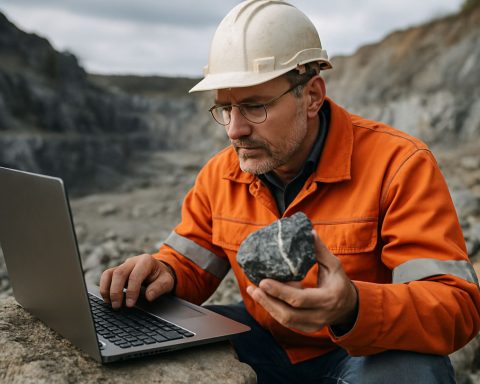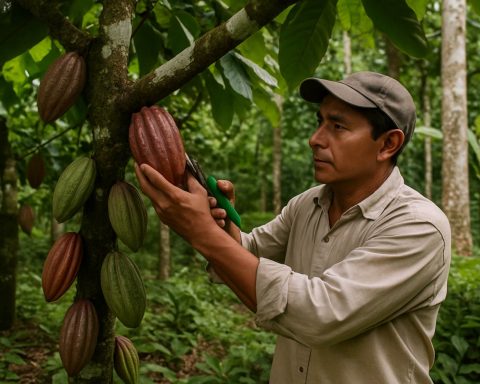Geological AI-Driven Mineral Exploration Market Report 2025: Unveiling Growth Drivers, Disruptive Technologies, and Global Opportunities. This comprehensive analysis explores market size, leading players, and the future of AI-powered mineral discovery.
- Executive Summary & Market Overview
- Key Technology Trends in AI-Driven Mineral Exploration
- Competitive Landscape and Leading Innovators
- Market Size, Growth Forecasts & CAGR Analysis (2025–2030)
- Regional Market Analysis & Investment Hotspots
- Challenges, Risks, and Emerging Opportunities
- Future Outlook: Strategic Recommendations & Industry Roadmap
- Sources & References
Executive Summary & Market Overview
Geological AI-driven mineral exploration refers to the application of artificial intelligence (AI) and machine learning (ML) technologies to analyze geological data, identify mineralization patterns, and optimize the discovery of new mineral deposits. This approach leverages vast and complex datasets—including geophysical, geochemical, remote sensing, and drilling data—to enhance the accuracy, speed, and cost-effectiveness of mineral exploration activities.
As of 2025, the global market for AI-driven mineral exploration is experiencing robust growth, driven by the mining sector’s increasing need to improve discovery rates, reduce exploration costs, and address the depletion of easily accessible ore bodies. The integration of AI technologies is enabling mining companies to process and interpret large-scale datasets more efficiently, leading to more informed decision-making and higher success rates in target identification.
According to Deloitte, digital transformation—including AI adoption—has become a strategic imperative for mining companies seeking to remain competitive in a challenging resource environment. The global mining industry’s digitalization market, which includes AI-driven exploration, is projected to reach USD 9.3 billion by 2027, growing at a CAGR of 13.2% from 2022 to 2027, as reported by MarketsandMarkets.
Key players in the geological AI-driven mineral exploration space include technology providers such as GoldSpot Discoveries, Earth AI, and Koan Analytics, as well as major mining companies like Rio Tinto and BHP that are investing in proprietary AI solutions. These organizations are leveraging AI to integrate disparate data sources, automate geological modeling, and generate predictive maps that highlight high-potential exploration targets.
Regionally, North America and Australia are leading adopters of AI-driven exploration, supported by advanced digital infrastructure, a strong mining sector, and government initiatives promoting innovation. However, emerging markets in Latin America and Africa are also beginning to embrace AI technologies to unlock new mineral resources and attract foreign investment.
In summary, geological AI-driven mineral exploration is transforming the mineral discovery process, offering significant advantages in efficiency, accuracy, and sustainability. As the mining industry continues to face resource scarcity and environmental pressures, the adoption of AI-driven solutions is expected to accelerate, shaping the future of mineral exploration globally.
Key Technology Trends in AI-Driven Mineral Exploration
Geological AI-driven mineral exploration is rapidly transforming the mining sector by leveraging advanced machine learning, computer vision, and data integration techniques to enhance the discovery and evaluation of mineral resources. In 2025, several key technology trends are shaping this field, enabling more efficient, accurate, and cost-effective exploration processes.
- Integration of Multisource Geoscientific Data: AI platforms are increasingly capable of synthesizing vast and diverse datasets, including geophysical surveys, geochemical assays, satellite imagery, and historical drilling records. This holistic data integration allows for more robust geological modeling and target generation, reducing the risk of false positives and overlooked deposits. Companies like Korea Resources Corporation and BHP are investing in AI systems that unify disparate data streams for comprehensive subsurface analysis.
- Automated Core Logging and Image Analysis: Computer vision algorithms are now routinely applied to high-resolution drill core images, automating the identification of mineralogy, textures, and structural features. This not only accelerates the logging process but also improves consistency and objectivity. Firms such as Orexplore Technologies are deploying AI-powered scanners that deliver real-time, 3D mineralogical data directly from drill cores.
- Predictive Targeting and Prospectivity Mapping: Machine learning models are being trained on known deposit signatures to predict new mineralization zones with high accuracy. These models can process complex, non-linear relationships in geological data, enabling the identification of subtle exploration targets that might be missed by traditional methods. GoldSpot Discoveries and Earth AI are at the forefront, offering AI-driven prospectivity maps that guide exploration investment decisions.
- Cloud-Based Collaboration and Real-Time Analytics: The adoption of cloud computing is facilitating real-time data sharing and collaborative interpretation among geologists, data scientists, and decision-makers across global operations. Platforms from providers like Seequent enable seamless integration of AI analytics into geological workflows, enhancing agility and responsiveness in exploration campaigns.
These technology trends are not only increasing the success rate of mineral discoveries but are also driving sustainability by minimizing unnecessary drilling and reducing the environmental footprint of exploration activities. As AI capabilities continue to mature, geological AI-driven mineral exploration is expected to become the industry standard by 2025 and beyond.
Competitive Landscape and Leading Innovators
The competitive landscape of geological AI-driven mineral exploration in 2025 is characterized by rapid technological advancements, increased investment, and a growing roster of both established mining companies and specialized technology startups. The sector is witnessing a paradigm shift as artificial intelligence (AI) and machine learning (ML) algorithms are increasingly deployed to analyze geological data, predict mineralization, and optimize exploration strategies. This shift is driven by the need to reduce exploration costs, improve discovery rates, and address the declining quality of easily accessible ore bodies.
Leading innovators in this space include a mix of global mining giants and agile technology firms. Rio Tinto and BHP have both invested heavily in AI-driven exploration platforms, leveraging proprietary datasets and advanced analytics to identify new deposits and streamline decision-making. These companies are integrating AI into their existing workflows, resulting in faster target generation and improved resource estimation accuracy.
On the technology front, companies such as OreFox and GoldSpot Discoveries are at the forefront of innovation. OreFox utilizes deep learning and data fusion techniques to interpret complex geological datasets, while GoldSpot Discoveries employs AI to uncover hidden patterns in geoscience data, assisting clients in making more informed exploration decisions. These firms often partner with mid-tier and junior miners, democratizing access to advanced exploration tools.
Another notable player is Koan Analytics, which specializes in AI-powered geospatial analysis, offering solutions that integrate satellite imagery, geophysical surveys, and geochemical data. Their platforms enable rapid regional assessments and high-resolution targeting, reducing the time and cost associated with traditional exploration methods.
Strategic collaborations and acquisitions are shaping the competitive dynamics. For example, Barrick Gold has entered into partnerships with AI startups to enhance its exploration pipeline, while venture capital investment in mining technology firms reached record highs in 2024, according to S&P Global Market Intelligence. This influx of capital is accelerating the development and deployment of AI solutions across the industry.
In summary, the 2025 landscape for geological AI-driven mineral exploration is defined by a blend of established mining corporations and nimble tech innovators, all vying to harness AI’s potential to unlock new mineral resources and maintain a competitive edge in a resource-constrained world.
Market Size, Growth Forecasts & CAGR Analysis (2025–2030)
The global market for geological AI-driven mineral exploration is poised for robust expansion between 2025 and 2030, driven by the mining sector’s increasing adoption of artificial intelligence (AI) to enhance exploration efficiency, reduce costs, and improve discovery rates. According to projections by MarketsandMarkets, the AI in mining market—which includes mineral exploration—was valued at approximately USD 650 million in 2023 and is expected to surpass USD 2.5 billion by 2030, reflecting a compound annual growth rate (CAGR) of over 21% during the forecast period.
This growth is underpinned by several key factors:
- Data Proliferation: The increasing availability of high-resolution geophysical, geochemical, and remote sensing data has created fertile ground for AI applications, enabling more accurate and rapid identification of mineralization zones.
- Cost Pressures: Mining companies are under pressure to optimize exploration budgets. AI-driven solutions can reduce the time and expense associated with traditional exploration methods, making them highly attractive in a capital-intensive industry.
- Technological Advancements: Advances in machine learning algorithms, cloud computing, and edge analytics are accelerating the deployment of AI tools in geological exploration, as noted by Deloitte.
- Regulatory and ESG Drivers: Stricter environmental, social, and governance (ESG) requirements are prompting companies to adopt AI for more targeted and less invasive exploration, reducing environmental footprints.
Regionally, North America and Australia are leading adopters, owing to their mature mining sectors and strong innovation ecosystems. However, emerging markets in Africa and South America are expected to witness the fastest growth, as AI-driven exploration helps unlock new mineral resources in underexplored regions (PwC).
Looking ahead to 2030, the market is expected to see continued consolidation, with major mining companies investing in proprietary AI platforms and startups specializing in geological data analytics. The CAGR of 21%+ underscores the sector’s rapid digital transformation and the critical role AI will play in the future of mineral discovery and resource development.
Regional Market Analysis & Investment Hotspots
The regional landscape for AI-driven mineral exploration in 2025 is shaped by a convergence of geological potential, digital infrastructure, and investment climate. North America, particularly Canada and the United States, remains at the forefront due to robust mining sectors, advanced research institutions, and supportive government initiatives. Canadian provinces such as Ontario and Quebec are notable hotspots, leveraging AI to unlock new deposits in the Abitibi Greenstone Belt and other prolific regions. Companies like GoldSpot Discoveries and Minerva Intelligence are actively deploying machine learning to reinterpret legacy geological data, leading to new discoveries and increased investor interest.
Australia is another key region, with Western Australia and Queensland attracting significant investment. The government’s Geoscience Australia and private sector players are integrating AI with geophysical and geochemical datasets to target critical minerals such as lithium, nickel, and rare earth elements. The Pilbara and Yilgarn Craton are focal points, with AI-driven prospectivity mapping accelerating exploration timelines and reducing costs.
In South America, Chile and Peru are emerging as AI adoption leaders, driven by their vast copper and lithium reserves. The Chilean government’s push for digital transformation in mining, combined with partnerships between local universities and global technology firms, is fostering a vibrant ecosystem for AI-based exploration. Codelco and other major miners are piloting AI tools to optimize drill targeting and resource estimation, making the Andes a magnet for foreign direct investment.
Africa’s mineral-rich regions, particularly in South Africa, Botswana, and the Democratic Republic of Congo, are beginning to see increased AI integration. While infrastructure and data quality remain challenges, international collaborations and funding from organizations like the World Bank are enabling pilot projects that demonstrate the value of AI in de-risking exploration in underexplored terrains.
- Investment Hotspots 2025:
- Abitibi Greenstone Belt (Canada): AI-driven reanalysis of historical data.
- Pilbara & Yilgarn (Australia): AI for critical minerals targeting.
- Andean Copper Belt (Chile/Peru): AI-optimized drill targeting.
- Central Africa: Early-stage AI pilots in high-potential regions.
Overall, regions with mature mining sectors, digital readiness, and supportive policy frameworks are leading in AI-driven mineral exploration, with investment flowing to areas where AI demonstrably enhances discovery rates and reduces exploration risk.
Challenges, Risks, and Emerging Opportunities
The integration of AI into geological mineral exploration is transforming the sector, but it also introduces a complex landscape of challenges, risks, and emerging opportunities as the industry moves into 2025. One of the primary challenges is the quality and availability of geological data. Many mining regions, especially in developing economies, lack comprehensive, high-resolution datasets, which can limit the effectiveness of AI models. Data heterogeneity—stemming from varied sources, formats, and historical inconsistencies—further complicates model training and deployment, potentially leading to inaccurate predictions or overlooked deposits (McKinsey & Company).
Another significant risk is the “black box” nature of many AI algorithms. Stakeholders, including geologists and investors, may be hesitant to trust exploration decisions driven by models whose internal logic is not easily interpretable. This lack of transparency can slow adoption and create regulatory hurdles, especially as governments increase scrutiny over resource extraction and environmental impact (Deloitte).
Cybersecurity is an emerging concern as exploration data and proprietary AI models become valuable assets. The risk of data breaches or intellectual property theft is heightened, particularly as companies increasingly rely on cloud-based platforms and remote data sharing (PwC).
Despite these challenges, the opportunities are substantial. AI-driven exploration can dramatically reduce the time and cost required to identify viable mineral targets, enabling companies to respond more quickly to market demand and price fluctuations. The technology also opens up previously uneconomical or inaccessible regions for exploration, as AI can process satellite imagery, geophysical data, and geochemical signatures at scale to pinpoint anomalies (Boston Consulting Group).
- AI enables more sustainable exploration by minimizing unnecessary drilling and reducing environmental disturbance.
- Collaboration between mining companies and AI startups is accelerating innovation, with new business models emerging around data sharing and platform-based exploration services.
- Regulatory bodies are beginning to recognize the potential of AI for improving transparency and compliance in mineral discovery, potentially streamlining permitting processes.
In summary, while geological AI-driven mineral exploration faces data, trust, and security challenges, the sector is poised for significant growth and transformation in 2025, driven by efficiency gains, sustainability imperatives, and new collaborative ecosystems.
Future Outlook: Strategic Recommendations & Industry Roadmap
The future outlook for geological AI-driven mineral exploration in 2025 is shaped by rapid technological advancements, evolving regulatory landscapes, and increasing demand for critical minerals. As the mining sector faces mounting pressure to improve efficiency, reduce environmental impact, and discover new deposits, AI-driven solutions are poised to become central to exploration strategies. Strategic recommendations and an industry roadmap are essential for stakeholders aiming to capitalize on these trends.
- Integration of Multisource Data: Companies should prioritize the integration of diverse geological, geophysical, and geochemical datasets. AI models excel when trained on large, high-quality datasets, enabling more accurate predictions of mineralization zones. Strategic partnerships with data providers and research institutions can enhance data access and model robustness (Rio Tinto).
- Investment in Talent and Infrastructure: The industry must invest in upskilling geoscientists and data scientists to bridge the gap between domain expertise and AI proficiency. Additionally, upgrading IT infrastructure to support high-performance computing and cloud-based analytics will be critical for real-time data processing and model deployment (BHP).
- Collaboration and Open Innovation: Open-source AI platforms and collaborative exploration initiatives can accelerate innovation and reduce costs. Industry consortia and public-private partnerships are expected to play a pivotal role in sharing best practices, datasets, and AI tools, fostering a more dynamic exploration ecosystem (United Nations Economic Commission for Europe (UNECE)).
- Regulatory Alignment and ESG Integration: As governments tighten environmental and social governance (ESG) requirements, AI-driven exploration must align with sustainable practices. Companies should leverage AI to minimize environmental footprints, improve stakeholder engagement, and ensure compliance with evolving regulations (International Council on Mining and Metals (ICMM)).
- Roadmap for 2025 and Beyond: The industry roadmap should focus on phased AI adoption—starting with pilot projects, scaling successful models, and embedding AI into core exploration workflows. By 2025, leaders are expected to achieve significant reductions in exploration costs and timelines, while improving discovery rates of critical minerals essential for the energy transition (McKinsey & Company).
In summary, the strategic adoption of AI in geological mineral exploration will be a key differentiator for mining companies in 2025, driving both competitive advantage and sustainable growth.
Sources & References
- Deloitte
- MarketsandMarkets
- Earth AI
- Koan Analytics
- Rio Tinto
- Orexplore Technologies
- OreFox
- PwC
- Codelco
- World Bank
- McKinsey & Company
- Rio Tinto
- International Council on Mining and Metals (ICMM)








